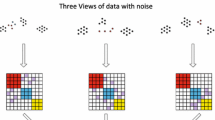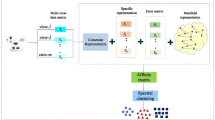Abstract
Multi-View Clustering (MVC) is a widely used paradigm in machine learning, which can effectively explore the complementary information in multiple views to discover the internal patterns of data. Existing MVC methods generally hold a hypothesis that all samples have complete view information, while in many real scenarios, the views information may be incomplete, since collecting complete views for each instance will result in large cost in labor and time. To solve this issue, we establish a novel method named Linear Neighborhood Reconstruction constrained Latent Subspace Discovery for incomplete multi-view clustering (LNRLSD), which jointly integrates latent representation learning, linear neighborhood reconstruction and spectral clustering into a unified framework. Concretely, the latent representation is learned firstly by matrix factorization to fully explore the complementarity of multiple views. Next, different from existing MVC methods that perform data reconstruction globally, we describe multi-view data in a local manner, which leads to a more clear block-diagonal structure for data distribution and makes the learned subspace representation more accurate. Finally, LNRLSD obtains the final clustering results by applying spectral clustering on the subspace representation. In summary, LNRLSD can make full use of both complementary knowledge and the local geometrical structure to improve clustering performance. Extensive experiments on five real-world datasets indicate that compared with several state-of-the-art methods, LNRLSD can achieve superior or comparable performance.



Similar content being viewed by others
References
Aeini F, Eftekhari Moghadam AM, Mahmoudi F (2019) A regularized approach for supervised multi-view multi-manifold learning from unlabeled data. Appl Intell 49:3173–3187
Appice A, Malerba D (2015) A co-training strategy for multiple view clustering in process mining. IEEE Trans Serv Comput 9(6):832–845
Chen MS, Huang L, Wang CD, Huang D (2020) Multi-view clustering in latent embedding space. In: Proceedings of the AAAI conference on artificial intelligence, vol 34, pp 3513– 3520
Elhamifar E, Vidal R (2013) Sparse subspace clustering: Algorithm, theory, and applications. IEEE Trans Pattern Anal Mach Intell 35(11):2765–2781
Gao H, Nie F, Li X, Huang H (2015) Multi-view subspace clustering. In: 2015 IEEE International conference on computer vision, pp 4238–4246
Guo D, Zhang J, Liu X, Cui Y, Zhao C (2014) Multiple kernel learning based multi-view spectral clustering. In: 2014 22nd International conference on pattern recognition, pp 3774– 3779
Hu M, Chen S (2018) Doubly aligned incomplete multi-view clustering. In: Proceedings of the twenty-seventh international joint conference on artificial intelligence, pp 2262–2268
Hu M, Chen S (2019) One-pass incomplete multi-view clustering. Proceedings of the AAAI conference on artificial intelligence 33:3838–3845
Kang Z, Shi G, Huang S, Chen W, Pu X, Zhou JT, Xu Z (2019) Multi-graph fusion for multi-view spectral clustering. Knowl.-Based Syst 189:105102
Li SY, Jiang Y, Zhou ZH (2014) Partial multi-view clustering. In: Proceedings of the AAAI conference on artificial intelligence, pp 1968–1974
Li Y, Liao H (2020) Multi-view clustering via adversarial view embedding and adaptive view fusion. Appl Intell 2:1–12
Li Y, Yang M, Zhang Z (2018) A survey of multi-view representation learning. IEEE Trans Knowl Data Eng 31(10):1863– 1883
Liu X, Zhu X, Li M, Wang L, Tang C, Yin J, Shen D, Wang H, Gao W (2019) Late fusion incomplete multi-view clustering. IEEE Trans Pattern Anal Mach Intell 41(10):2410–2423
Patel VM, Van Nguyen H, Vidal R (2013) Latent space sparse subspace clustering. In: Proceedings of the IEEE international conference on computer vision
Shao W, He L, Philip SY (2015) Multiple incomplete views clustering via weighted nonnegative matrix factorization with L2,1 regularization. In: Joint European conference on machine learning and knowledge discovery in databases. Springer, pp 318– 334
Sun S (2013) A survey of multi-view machine learning. Neural Comput Appl 23(7-8):2031–2038
Tan Q, Yu G, Domeniconi C, Wang J, Zhang Z (2018) Incomplete multi-view weak-label learning. In: Proceedings of the twenty-seventh international joint conference on artificial intelligence, pp 2703–2709
Tao H, Hou C, Yi D, Zhu J, Hu D (2019) Joint embedding learning and low-rank approximation: A framework for incomplete multiview learning .IEEE Trans Cybern :1–14
Trivedi A, Rai P, Daumé H III, DuVall SL (2010) Multiview clustering with incomplete views. In: NIPS workshop, vol 224. pp. 1–7
Tzortzis G, Likas A (2012) Kernel-based weighted multi-view clustering. In: 2012 IEEE 12th International conference on data mining, pp 675–684
Wang DB, Li L, Zhang ML (2019) Adaptive graph guided disambiguation for partial label learning. In: Proceedings of the 25th ACM International conference on knowledge discovery & data mining. pp 83–91
Wang H, Yang Y, Liu B (2020) GMC: Graph-based multi-view clustering. IEEE Trans Knowl Data Eng 32(6):1116–1129
Wang Q, Ding Z, Tao Z, Gao Q, Fu Y (2018) Partial multi-view clustering via consistent GAN. In: 2018 IEEE International conference on data mining. IEEE, pp 1290–1295
Wang XD, Chen RC, Yan F, Zeng ZQ, Hong CQ (2019) Fast adaptive k-means subspace clustering for high-dimensional data. IEEE Access :42639–42651
Wang Y, Liu X, Dou Y, Li R (2017) Multiple kernel clustering framework with improved kernels. In: Proceedings of the Twenty-sixth international joint conference on artificial intelligence. pp 2999–3005
Wen J, Xu Y, Liu H (2020) Incomplete multiview spectral clustering with adaptive graph learning. IEEE Trans Cybern 50(4):1418–1429
Wen J, Yan K, Zhang Z, Xu Y, Wang J, Fei L, Zhang B (2020) Adaptive graph completion based incomplete multi-view clustering. IEEE Trans Multimed :1–12
Xu C, Tao D, Xu C (2013) A survey on multi-view learning. arXiv:1304.5634
Xu C, Tao D, Xu C (2015) Multi-view learning with incomplete views. IEEE Trans Image Process 24(12):5812–5825
Xu N, Guo Y, Zheng X, Wang Q, Luo X (2018) Partial multi-view subspace clustering. In: Proceedings of the 26th ACM International conference on multimedia, pp 1794–1801
Yan F, Wang XD, Zeng ZQ, Hong CQ (2019) Adaptive multi-view subspace clustering for high-dimensional data. Pattern Recogn Lett 130:299–305
Zhang C, Fu H, Wang J, Li W, Hu Q (2020) Tensorized multi-view subspace representation learning. Int J Comput Vis 9:2344–2361
Zhang C, Hu Q, Fu H, Zhu P, Cao X (2017) Latent multi-view subspace clustering. In: Proceedings of the IEEE conference on computer vision and pattern recognition, pp 4279–4287
Zhao H, Liu H, Fu Y (2016) Incomplete multi-modal visual data grouping. In: Proceedings of the twenty-fifth international joint conference on artificial intelligence, pp 2392–2398
Zhao L, Chen Z, Yang Y, Wang ZJ, Leung VCM (2017) Incomplete multi-view clustering via deep semantic mapping. Neurocomputing 275(JAN.31):1053–1062
Zhao X, Evans N, Dugelay JL (2014) A subspace co-training framework for multi-view clustering. Pattern Recogn Lett 41:73–82
Zhuge W, Hou C, Liu X, Tao H, Yi D (2019) Simultaneous representation learning and clustering for incomplete multi-view data. In: Proceedings of the twenty-eighth international joint conference on artificial intelligence. pp 4482–4488
Author information
Authors and Affiliations
Corresponding author
Additional information
Publisher’s note
Springer Nature remains neutral with regard to jurisdictional claims in published maps and institutional affiliations.
Rights and permissions
About this article
Cite this article
Zhao, J., Lyu, G. & Feng, S. Linear neighborhood reconstruction constrained latent subspace discovery for incomplete multi-view clustering. Appl Intell 52, 982–993 (2022). https://doi.org/10.1007/s10489-021-02417-z
Accepted:
Published:
Issue Date:
DOI: https://doi.org/10.1007/s10489-021-02417-z




